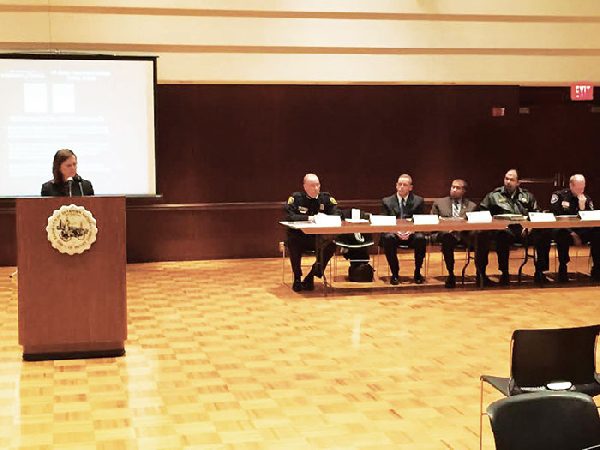
|
| U.S. Attorney Barbara McQuade stresses the importance of law enforcement agency collaboration. |
DEARBORN — On Tuesday, Jan. 13, the Dearborn Police Department held a press conference with multiple law enforcement agencies at the Ford Community & Performing Arts Center to share details of their “Operation Blue Light II” initiative.
Introduced in 2014 with the participation of agencies including Dearborn, Detroit, Dearborn Heights, Livonia, Redford, Taylor, Westland, Wayne State University, the Wayne County Sheriff’s Department, the FBI, Homeland Security and the U.S. Attorney’s Office, among others, the initiative is described as a collaborative effort to disrupt the criminal process and improve safety on a regional level.
The majority of law enforcement agencies in Wayne County collaborated between Dec. 15 and Dec. 31 to apprehend wanted individuals residing in and around Wayne County and targeted those who committed larceny, retail crimes and other offenses.
During this period, the agencies involved in the initiative were able to stop 16,653 vehicles. From there, the agencies issued 14,811 ULC’s and impounded 1,346 vehicles. The initiative also led to the arrests of more than 2,500 individuals, with 1,436 of them being linked to misdemeanor offenses, 591 related to warrant arrests and 408 being felony arrests.
The agencies also confiscated 62 weapons.
At the press conference, U.S. Attorney Barbara McQuade discussed progressive cases during the operation, which included identifying and arresting two men linked to the armed robberies of four dollar stores. Three of the stores were in Detroit; the fourth in Dearborn.
McQuade said that with the assistance of the media, along with the cooperation of the FBI’s Violent Crime Task Force and the Detroit and Dearborn Police Departments, the men were charged in federal court on eight counts of the indictment for interference with commerce by robbery and for use of a firearm during and in relation to a crime of violence. The men could face more than 80 years in prison.
“Criminals think they can get away with it if they commit one crime in one community and another crime in another, because it’s different police departments,” said McQuade. “But when these agencies share that information, put their heads together and work together, we can solve a lot of crimes and we can defeat those efforts by criminals. It’s also an example of when the community and news media are coming together with law enforcement and are working together.”
The initiative was also successful in capturing three sisters who had committed multiple larcenies at various Walgreens and other pharmacy stores in Dearborn, Redford, Detroit and Farmington Hills.
On December 24, the women were finally arrested after stealing four boxes of Prilosec at a Dearborn Walgreens at Warren and Schaefer. Walgreens management recognized them from previous larcenies and when an employee attempted to get the license plate number of their vehicle, the women used pepper spray against the employee in retaliation.
Dearborn Police captured the sisters just a few minutes later on I-96 and Wyoming. They had approximately $4,000 worth of merchandise in their vehicle, believed to have been confiscated from other stores. One suspect was charged with third degree flee and elude; the second was charged with robbery not armed and third degree retail fraud; while the third, a juvenile, was transferred to the Wayne County Youth Home to await charges.
Dearborn Police Chief Ron Haddad took the podium to discuss the importance of community assistance during these types of operations. He thanked the media for being able to promptly spread information related to time-sensitive crimes, which have resulted in the agencies receiving overwhelming feedback and tips from residents.
Haddad referenced a double homicide that occurred in Dearborn in 2013 at a Family Dollar store on Michigan Ave. Last month, the murderer of Brenna Machus and Joseph Orlando was sentenced to life in prison without parole.
“The media put the heat on the entire community and brought that case to a closure,” Haddad said. “Here at the city of Dearborn we have almost 9,000 people on our NIXLE. When we get a video, a sketch or picture of an unidentified perpetrator, we put it out in the community and our biggest hassle after that is to make sure we have somebody answering the phone calls.”
Haddad also attributed the department’s heavy involvement in Operation Blue Light to the persistence of Mayor Jack O’Reilly, who he said worked to maintain a respectable budget within the police department that allows them to utilize plenty of resources.
O’Reilly discussed the success of the initiative and encouraged other agencies to work with neighboring departments in solving crimes and capturing offenders. He added that he’s already worked with neighboring cities in developing cohesive economic and social projects that would positively impact communities as a board member of the Downriver Community Conference and the Conference of Western Wayne. He is hopeful that law enforcement agencies will continue collaborating to reduce crime as well.
“It really is all about the cooperation of local jurisdictions,” O’Reilly said. “I just want to lend my support to that concept. We have seen the value of collaboration and what can happen. This is an expansion of what has been growing over time; and I am a huge advocate of joint enterprise, where we come together and don’t let pre-existing boundaries prevent us from doing what’s the best thing to do. We need to start looking beyond our isolated borders and start looking at what’s the most meaningful way that we can interact and get things done.”






Leave a Reply